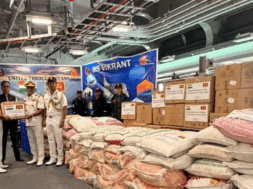
Economy: Inflation manageable in India, says FM Nirmala Sitharaman
Virendra Pandit
New Delhi: After the positive signs from the Reserve Bank of India (RBI) and Moody’s this week, Finance Minister Nirmala Sitharaman said on Wednesday that the country’s economic growth remains a priority for the government as inflation has come down to a manageable level.
Speaking at the India Ideas Summit, she exuded confidence that the central bank would manage the volatility emerging from the aggressive rate hike stance by its counterparts worldwide, like the US Fed and the European Central Bank.
Job creation and equitable distribution of wealth remain the government’s other focus areas.
“Some, of course, are red-lettered (priorities); some may not be. Red-lettered ones would, of course, be jobs, fair wealth distribution, and ensuring India is moving on the path of growth.
“Inflation is not red-lettered. I hope it doesn’t surprise many of you. We have shown that we could bring it to a manageable level in the past couple of months,” Sitharaman said.
According to official data, retail inflation softened to 6.71 percent in July because of moderation in food prices. Still, it remained above the RBI’s comfort level of 6 percent for the seventh consecutive month.
The Consumer Price Index (CPI) based retail inflation was at 7.01 percent in June and 5.59 percent in July 2021. It was above 7 percent from April to June this fiscal.
Regarding fiscal management during the Covid-19 period, Sitharaman said India managed through a challenging time without printing money with a targeted budgetary policy.
Referring to the global energy crisis triggered by the ongoing Russia-Ukraine war, she said uncertainty over the availability of crude and natural gas continues.
She also urged deepening ties between India and the US, including payment technology.
On Tuesday, Moody’s Investors Service kept India’s sovereign rating at Baa3 with a stable outlook. It said that rising challenges to the global economy, including the impact of the Russia-Ukraine war, higher inflation, and tightening financial conditions on the back of policy tightening, are unlikely to derail the country’s ongoing recovery from the pandemic in 2022 and 2023. It had also pegged real GDP growth at 7.6 percent for 2022-23.
RBI Governor Shaktikanta Das had, on Monday, said the country’s foreign exchange reserves of over USD 561 billion provide a cushion against external shocks.
India had a six-sided buffer, including a favorable growth differential, lower inflation than many of its trading partners, a forex reserve cushion, and a sound banking system built around its economy, which every financial market participant must remember.
India is among the fastest growing major economies in the world in 2022, when the other major economies may encounter recession or considerable moderation in their growth momentum.
“The favorable growth differential of India provides confidence to investors. It amply reflected this in the surge of portfolio flows into India since July 2022. Inflows in August alone, at USD 7.5 billion, are over 16 times the net inflows in July,” he said at an event.
The recent softening of commodity prices and supply chain pressures have eased the terms of the trade shock that India faced in the pandemic’s aftermath and the war. With the consequent easing of imported inflation pressures, he said India’s CPI inflation peaked in April 2022.
The RBI chief noted that the shift in the commodity price outlook also altered the assessment of India’s current account deficit in 2022–23, which is now expected to remain well within sustainable levels.
“When food security is threatened the world over by shortages and soaring prices, India’s large buffer stocks of food grains supplement domestic supply and assure food security domestically,” he said.
Das underscored that India’s foreign exchange reserves of USD 561 billion (as of August 26) provide a cushion against external shocks, as is being shown daily. Forward assets also reinforced the funds.
“The health of our banking system is sound. It is well capitalized and well provisioned, with improved asset quality. This makes up a key pillar of financial stability and is expected to provide positive spill-overs for the financial markets,” he said.
Reflecting on these fundamental factors, he said the Indian Rupee (INR) has moved orderly in the current financial year. “It has held its own in a world of sharp depreciation across other emerging market economy and advanced economy currencies.”
“While the US dollar has appreciated by 11.8 percent during the current financial year so far, the INR has depreciated by 5.1 percent, which is among the lowest in the world,” Das added.














